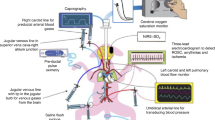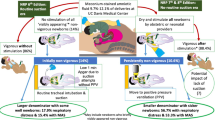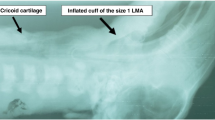Abstract
Background:
Current neonatal resuscitation guidelines recommend tracheal suctioning of nonvigorous neonates born through meconium-stained amniotic fluid.
Methods:
We evaluated the effect of tracheal suctioning at birth in 29 lambs with asphyxia induced by cord occlusion and meconium aspiration during gasping.
Results:
Tracheal suctioning at birth (n = 15) decreased amount of meconium in distal airways (53 ± 29 particles/mm2 lung area) compared to no suction (499 ± 109 particles/mm2; n = 14; P < 0.001). Three lambs in the suction group had cardiac arrest during suctioning, requiring chest compressions and epinephrine. Onset of ventilation was delayed in the suction group (146 ± 11 vs. 47 ± 3 s in no-suction group; P = 0.005). There was no difference in pulmonary blood flow, carotid blood flow, and pulmonary or systemic blood pressure between the two groups. Left atrial pressure was significantly higher in the suction group. Tracheal suctioning resulted in higher Pao2/FiO2 levels (122 ± 21 vs. 78 ± 10 mm Hg) and ventilator efficiency index (0.3 ± 0.05 vs.0.16 ± 0.03). Two lambs in the no-suction group required inhaled nitric oxide. Lung 3-nitrotyrosine levels were higher in the suction group (0.65 ± 0.03 ng/µg protein) compared with the no-suction group (0.47 ± 0.06).
Conclusion:
Tracheal suctioning improves oxygenation and ventilation. Suctioning does not improve pulmonary/systemic hemodynamics or oxidative stress in an ovine model of acute meconium aspiration with asphyxia.
Similar content being viewed by others
Log in or create a free account to read this content
Gain free access to this article, as well as selected content from this journal and more on nature.com
or
References
Bacsik RD . Meconium aspiration syndrome. Pediatr Clin North Am 1977;24:463–79.
Dillard RG . Neonatal tracheal aspiration of meconium-stained infants. J Pediatr 1977;90:163–4.
Fox WW, Gutsche BB, DeVore JS . A delivery room approach to the meconium aspiration syndrome (MAS). Immediate intubation, endotracheal suction, and oxygen administration can reduce morbidity and mortality. Clin Pediatr (Phila) 1977;16:325–8.
Goodlin RC . Suppression of fetal breathing to prevent aspiration of meconium. Obstet Gynecol 1970;36:944–7.
Goodlin RC . The prevention of meconium aspiration in labor using amnioinfusion. Obstet Gynecol 1989;74(3 Pt 1):430–1.
Fraser WD, Hofmeyr J, Lede R, et al.; Amnioinfusion Trial Group. Amnioinfusion for the prevention of the meconium aspiration syndrome. N Engl J Med 2005;353:909–17.
Vain NE, Szyld EG, Prudent LM, Wiswell TE, Aguilar AM, Vivas NI . Oropharyngeal and nasopharyngeal suctioning of meconium-stained neonates before delivery of their shoulders: multicentre, randomised controlled trial. Lancet 2004;364:597–602.
Wiswell TE, Gannon CM, Jacob J, et al. Delivery room management of the apparently vigorous meconium-stained neonate: results of the multicenter, international collaborative trial. Pediatrics 2000;105(1 Pt 1):1–7.
Kattwinkel J . Textbook of Neonatal Resuscitation. 6th edn. Elk Grove Village, IL: American Academy of Pediatrics, 2011.
Aub-Shaweesh JM . Respiratory disorders in preterm and term infants. In: Martin RJ, Fanaroff AA, Walsh MC, eds. Fanaroff and Martin’s Neonatal Perinatal Medicine. 9th edn. St. Louis, MO: Elsevier, 2010:1157–60.
Al Takroni AM, Parvathi CK, Mendis KB, Hassan S, Reddy I, Kudair HA . Selective tracheal suctioning to prevent meconium aspiration syndrome. Int J Gynaecol Obstet 1998;63:259–63.
Perlman JM, Wyllie J, Kattwinkel J, et al.; Neonatal Resuscitation Chapter Collaborators. Part 11: neonatal resuscitation: 2010 International Consensus on Cardiopulmonary Resuscitation and Emergency Cardiovascular Care Science With Treatment Recommendations. Circulation 2010;122:Suppl 2:S516–38.
Jeng MJ, Yang SS, Wolfson MR, Shaffer TH . Perfluorochemical (PFC) combinations for acute lung injury: an in vitro and in vivo study in juvenile rabbits. Pediatr Res 2003;53:81–8.
Velaphi S, Van Kwawegen A . Meconium aspiration syndrome requiring assisted ventilation: perspective in a setting with limited resources. J Perinatol 2008;28:Suppl 3:S36–42.
Wiswell TE, Peabody SS, Davis JM, Slayter MV, Bent RC, Merritt TA . Surfactant therapy and high-frequency jet ventilation in the management of a piglet model of the meconium aspiration syndrome. Pediatr Res 1994;36:494–500.
Simpson CM, Smolich JJ, Shekerdemian LS, Penny DJ . Urotensin-II contributes to pulmonary vasoconstriction in a perinatal model of persistent pulmonary hypertension of the newborn secondary to meconium aspiration syndrome. Pediatr Res 2010;67:150–7.
Cornish JD, Dreyer GL, Snyder GE, et al. Failure of acute perinatal asphyxia or meconium aspiration to produce persistent pulmonary hypertension in a neonatal baboon model. Am J Obstet Gynecol 1994;171:43–9.
Hsieh TK, Su BH, Chen AC, Lin TW, Tsai CH, Lin HC . Risk factors of meconium aspiration syndrome developing into persistent pulmonary hypertension of newborn. Acta Paediatr Taiwan 2004;45:203–7.
Velaphi S, Vidyasagar D . The pros and cons of suctioning at the perineum (intrapartum) and post-delivery with and without meconium. Semin Fetal Neonatal Med 2008;13:375–82.
Van Dyke RB, Spector SA . Transmission of herpes simplex virus type 1 to a newborn infant during endotracheal suctioning for meconium aspiration. Pediatr Infect Dis 1984;3:153–6.
Galinsky R, Moss TJ, Polglase GR, Hooper SB . Intrauterine inflammation alters cardiopulmonary but not cerebral hemodynamics during open endotracheal tube suction in preterm lambs. Pediatr Res 2013;74:48–53.
Carson BS, Losey RW, Bowes WA Jr, Simmons MA . Combined obstetric and pediatric approach to prevent meconium aspiration syndrome. Am J Obstet Gynecol 1976;126:712–5.
Gregory GA, Gooding CA, Phibbs RH, Tooley WH . Meconium aspiration in infants–a prospective study. J Pediatr 1974;85:848–52.
Ting P, Brady JP . Tracheal suction in meconium aspiration. Am J Obstet Gynecol 1975;122:767–71.
Kattwinkel J, Perlman JM, Aziz K, et al. Part 15: neonatal resuscitation: 2010 American Heart Association Guidelines for Cardiopulmonary Resuscitation and Emergency Cardiovascular Care. Circulation 2010;122:Suppl 3:S909–19.
Bent RC, Wiswell TE, Chang A . Removing meconium from infant tracheae. what works best? Am J Dis Child 1992;146:1085–9.
Akazawa Y, Ishida T, Baba A, Hiroma T, Nakamura T . Intratracheal catheter suction removes the same volume of meconium with less impact on desaturation compared with meconium aspirator in meconium aspiration syndrome. Early Hum Dev 2010;86:499–502.
Wedgwood S, Steinhorn RH . Role of reactive oxygen species in neonatal pulmonary vascular disease. Antioxid Redox Signal 2014;21;1926–42.
Lu MP, Du LZ, Chen XX, Gu WZ . Meconium aspiration increases iNOS expression and nitrotyrosine formation in the rat lung. World J Pediatr 2006:1;61–6.
Lotze A, Mitchell BR, Bulas DI, Zola EM, Shalwitz RA, Gunkel JH . Multicenter study of surfactant (beractant) use in the treatment of term infants with severe respiratory failure. Survanta in Term Infants Study Group. J Pediatr 1998;132:40–7.
El Shahed AI, Dargaville P, Ohlsson A, Soll RF . Surfactant for meconium aspiration syndrome in full term/near term infants. Cochrane Database Syst Rev 2007:CD002054.
Polin RA, Carlo WA ; Committee on Fetus and Newborn; American Academy of Pediatrics. Surfactant replacement therapy for preterm and term neonates with respiratory distress. Pediatrics 2014;133:156–63.
Lakshminrusimha S, Russell JA, Wedgwood S, et al. Superoxide dismutase improves oxygenation and reduces oxidation in neonatal pulmonary hypertension. Am J Respir Crit Care Med 2006;174:1370–7.
Miller AA, Drummond GR, Schmidt HH, Sobey CG . NADPH oxidase activity and function are profoundly greater in cerebral versus systemic arteries. Circ Res 2005;97:1055–62.
Streeter EY, Badoer E, Woodman OL, Hart JL . Effect of type 1 diabetes on the production and vasoactivity of hydrogen sulfide in rat middle cerebral arteries. Physiol Rep 2013;1:e00111.
Lakshminrusimha S, Steinhorn RH, Wedgwood S, et al. Pulmonary hemodynamics and vascular reactivity in asphyxiated term lambs resuscitated with 21 and 100% oxygen. J Appl Physiol (1985) 2011;111:1441–7.
Dupont WD, Plummer WD Jr . Power and sample size calculations for studies involving linear regression. Control Clin Trials 1998;19:589–601.
Author information
Authors and Affiliations
Corresponding author
Rights and permissions
About this article
Cite this article
Lakshminrusimha, S., Mathew, B., Nair, J. et al. Tracheal suctioning improves gas exchange but not hemodynamics in asphyxiated lambs with meconium aspiration. Pediatr Res 77, 347–355 (2015). https://doi.org/10.1038/pr.2014.186
Received:
Accepted:
Published:
Issue date:
DOI: https://doi.org/10.1038/pr.2014.186
This article is cited by
-
Neonatal outcomes of non-vigorous neonates with meconium-stained amniotic fluid before and after change in tracheal suctioning recommendation
Journal of Perinatology (2022)
-
Change in neonatal resuscitation guidelines and trends in incidence of meconium aspiration syndrome in California
Journal of Perinatology (2020)
-
Neonatal resuscitation adhering to oxygen saturation guidelines in asphyxiated lambs with meconium aspiration
Pediatric Research (2016)
-
Persistent pulmonary hypertension of the newborn
Maternal Health, Neonatology and Perinatology (2015)



